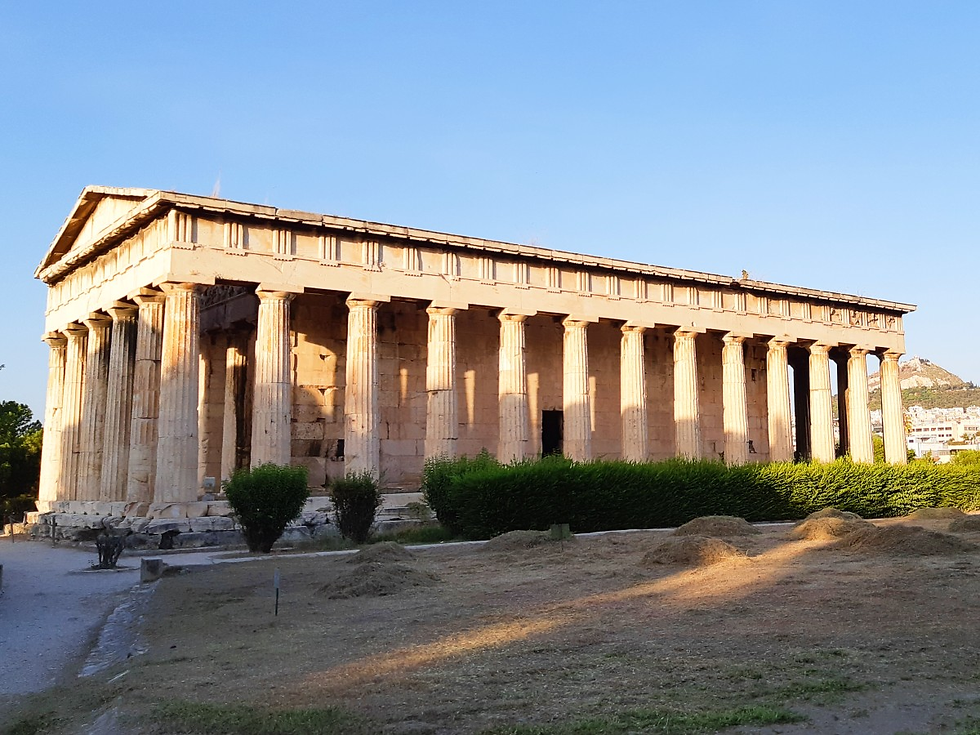Highlights, such as the Temple of Hephaestus and Stoa of Attalos
- Johnny Ka
- Jul 30, 2023
- 3 min read
Updated: Aug 4, 2023
Introduction:
When exploring the historical treasures of Athens, Greece, the Ancient Agora stands out as a captivating archaeological site that offers a glimpse into the city's rich cultural and architectural heritage. Within the Agora, two standout structures, the Temple of Hephaestus and the Stoa of Attalos, shine as prime examples of ancient Greek craftsmanship and hold immense historical and cultural significance. In this review, we will delve into the highlights of these remarkable structures, shedding light on their architectural beauty, historical importance, and the stories they tell about ancient Athens.

The Temple of Hephaestus:
Standing proudly atop the Agoraios Kolonos hill, the Temple of Hephaestus, also known as the Hephaesteion, is a true marvel of ancient Greek architecture. Built in the 5th century BCE, this well-preserved Doric temple was dedicated to Hephaestus, the god of fire and craftsmanship. Its grandeur and exquisite craftsmanship make it one of the best-preserved ancient Greek temples in existence.

The temple's exterior features beautiful marble columns and intricate friezes depicting scenes from Greek mythology, showcasing the artistic skill and attention to detail of the ancient craftsmen. The interior, though not accessible to visitors, would have housed a statue of Hephaestus, further emphasizing the temple's religious significance.
The Temple of Hephaestus not only stands as a testament to ancient Greek architecture but also provides valuable insights into the religious practices and beliefs of the Athenians. As you stroll through its majestic colonnades and admire the meticulously carved reliefs, you can't help but feel transported back in time to an era when the gods held great influence over daily life in Athens.
The Stoa of Attalos:
Located on the eastern side of the Agora, the Stoa of Attalos is a meticulously reconstructed ancient building that offers a fascinating glimpse into the commercial and social life of ancient Athens. Originally built by King Attalos II of Pergamon in the 2nd century BCE, the Stoa was a covered walkway lined with shops and spaces for public gatherings.

Today, the Stoa of Attalos serves as a museum, displaying a wide range of artifacts discovered during archaeological excavations in the Agora. The museum provides visitors with a unique opportunity to explore the daily lives and material culture of ancient Athenians.
Inside the Stoa, you can marvel at the well-preserved marble columns and the intricate architectural details that have been faithfully restored to their original splendor. The museum's collection includes pottery, sculptures, coins, and everyday objects, giving you a comprehensive overview of ancient Athenian life.
As you wander through the Stoa, you can imagine the bustling activity that once took place here—the sounds of merchants hawking their wares, the laughter of friends engaging in animated conversations, and the exchange of goods that fueled the economic engine of ancient Athens. The Stoa of Attalos serves as a bridge between the past and the present, connecting visitors to the vibrant commercial and social life of ancient Athens.
The Significance of These Structures:
The Temple of Hephaestus and the Stoa of Attalos not only showcase the remarkable craftsmanship and architectural ingenuity of the ancient Greeks but also hold significant historical and cultural importance.
The Temple of Hephaestus, dedicated to the god of craftsmanship, is a testament to the central role of art and skilled labor in ancient Athenian society. It stands as a symbol of Athenian pride in their artistic achievements and reflects their devotion to the gods.
The Stoa of Attalos, on the other hand, speaks to the commercial and social dynamics of ancient Athens. It demonstrates the importance of trade, commerce, and public gathering spaces in the city's bustling Agora. The Stoa's reconstruction allows visitors to immerse themselves in the vibrant atmosphere of ancient Athens and gain a deeper understanding of the city's economic and social fabric.
Conclusion:
The Temple of Hephaestus and the Stoa of Attalos within the Ancient Agora are undoubtedly highlights of any visit to Athens, offering a captivating journey into the ancient city's architectural, religious, and social past.
Through the Temple of Hephaestus, visitors can admire the magnificence of ancient Greek architecture while connecting with the religious beliefs and practices of the Athenians. The Stoa of Attalos, with its reconstructed façade and insightful museum, provides a vibrant window into the bustling commercial and social life of ancient Athens.
These structures stand as reminders of the enduring legacy of ancient Greek civilization, inviting us to marvel at the achievements of our ancestors and gain a deeper appreciation for the rich cultural tapestry that has shaped Athens and the world.




Comments